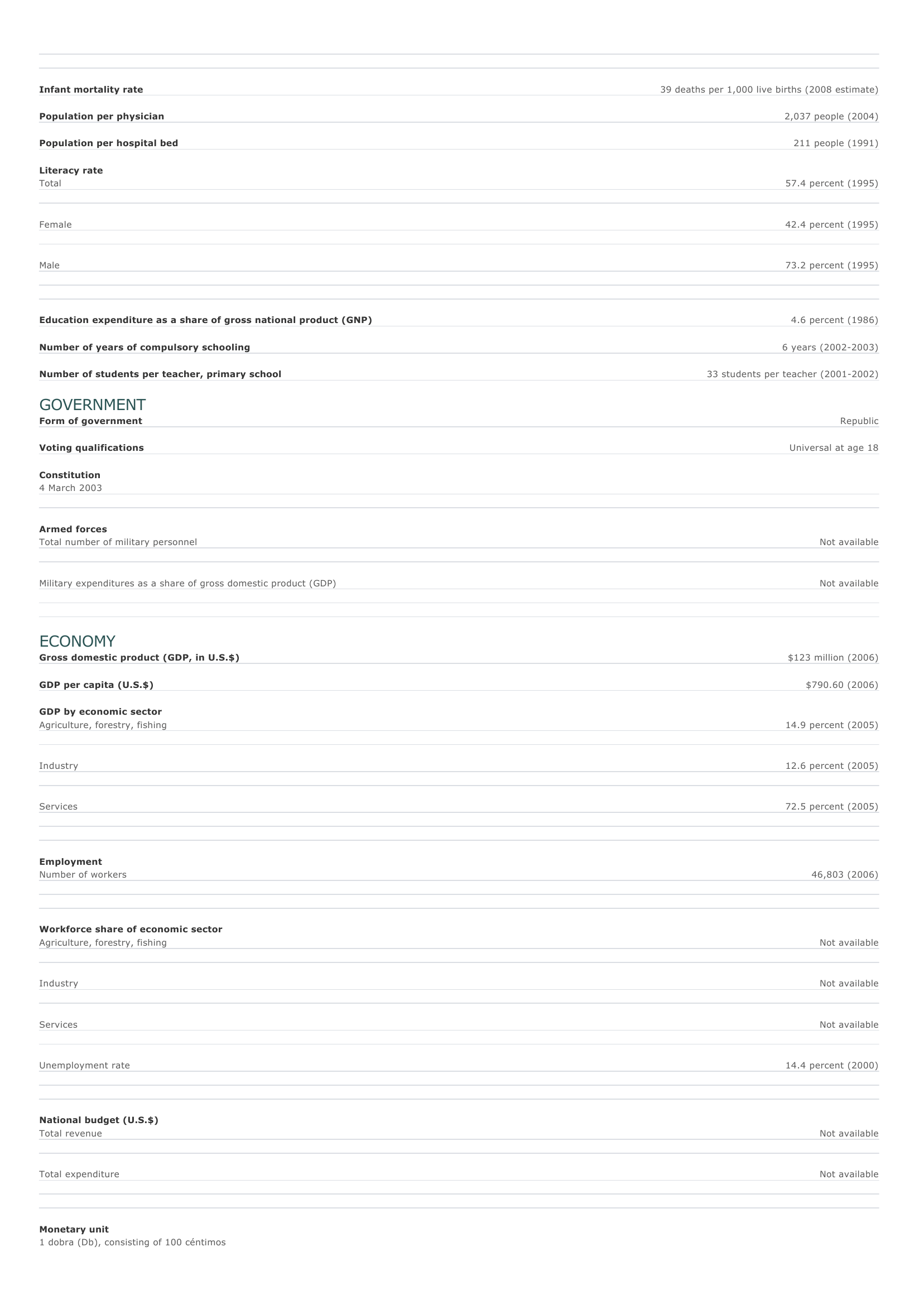São Tomé and Príncipe Facts and Figures. BASIC FACTS Official name Democratic Republic of São Tomé and Príncipe Capital Area São Tomé 1,001 sq km 386 sq mi PEOPLE Population Population growth Population growth rate 205,901 (2008 estimate) 3.11 percent (2008 estimate) Projected population in 2025 328,825 (2025 estimate) Projected population in 2050 502,489 (2050 estimate) Population density 206 persons per sq km (2008 estimate) 533 persons per sq mi (2008 estimate) Urban/rural distribution Share urban 38 percent (2005 estimate) Share rural 62 percent (2005 estimate) Largest cities, with population São Tomé 54,000 (2003 estimate) Ethnic groups Mestiço, angolares (descendants of Angolan slaves), forros (descendants of freed slaves), serviçais (contract laborers from Angola, Mozambique, and Cape Verde), tongas (children of serviçais born on the islands), Europeans Languages Portuguese (official), Fang Religious affiliations Christian 95 percent Roman Catholic 75 percent Protestant Other Christians 4 percent 16 percent Baha'i 2 percent Indigenous beliefs 1 percent O ther 2 percent HEALTH AND EDUCATION Life expectancy Total 68 years (2008 estimate) Female 69.7 years (2008 estimate) Male 66.3 years (2008 estimate) Infant mortality rate Population per physician Population per hospital bed 39 deaths per 1,000 live births (2008 estimate) 2,037 people (2004) 211 people (1991) Literacy rate Total 57.4 percent (1995) Female 42.4 percent (1995) Male 73.2 percent (1995) Education expenditure as a share of gross national product (GNP) Number of years of compulsory schooling Number of students per teacher, primary school 4.6 percent (1986) 6 years (2002-2003) 33 students per teacher (2001-2002) GOVERNMENT Form of government Republic Voting qualifications Universal at age 18 Constitution 4 March 2003 Armed forces Total number of military personnel Not available Military expenditures as a share of gross domestic product (GDP) Not available ECONOMY Gross domestic product (GDP, in U.S.$) GDP per capita (U.S.$) $123 million (2006) $790.60 (2006) GDP by economic sector Agriculture, forestry, fishing 14.9 percent (2005) I ndustry 12.6 percent (2005) Services 72.5 percent (2005) Employment Number of workers 46,803 (2006) Workforce share of economic sector Agriculture, forestry, fishing Not available I ndustry Not available Services Not available Unemployment rate 14.4 percent (2000) National budget (U.S.$) Total revenue Not available Total expenditure Not available Monetary unit 1 dobra (Db), consisting of 100 céntimos Major trade partners for exports Netherlands, Portugal, Turkey, Poland, and Canada Major trade partners for imports Portugal, United States, United Kingdom, Belgium, and France ENERGY, COMMUNICATIONS, AND TRANSPORTATION Electricity production Electricity from thermal sources 53.33 percent (2003 estimate) Electricity from hydroelectric sources 46.67 percent (2003 estimate) Electricity from nuclear sources 0 percent (2003 estimate) Electricity from geothermal, solar, and wind sources 0 percent (2003 estimate) Number of radios per 1,000 people 300 (1998 estimate) Number of telephones per 1,000 people 46 (2004) Number of televisions per 1,000 people 213 (2000 estimate) Number of Internet hosts per 10,000 people Daily newspaper circulation per 1,000 people Number of motor vehicles per 1,000 people Paved road as a share of total roads 70 (2003) Not available 41 (1997) 68 percent (1999) SOURCES Basic Facts and People sections Area data are from the statistical bureaus of individual countries. Population, population growth rate, and population projections are from the United States Census Bureau, International Programs Center, International Data Base (IDB) (www.census.gov). Urban and rural population data are from the Food and Agriculture Organization (FAO) of the United Nations (UN), FAOSTAT database (www.fao.org). Largest cities population data and political divisions data are from the statistical bureaus of individual countries. Ethnic divisions and religion data are largely from the latest Central Intelligence Agency (CIA) World Factbook and from various country censuses and reports. Language data are largely from the Ethnologue, Languages of the World, Summer Institute of Linguistics International (www.sil.org). Health and Education section Life expectancy and infant mortality data are from the United States Census Bureau, International Programs Center, International database (IDB) (www.census.gov). Population per physician and population per hospital bed data are from the World Health Organization (WHO) (www.who.int). Education data are from the United Nations Educational, Scientific and Cultural Organization (UNESCO) database (www.unesco.org). Government section Government, independence, legislature, constitution, highest court, and voting qualifications data are largely from various government Web sites, the latest Europa World Yearbook, and the latest Central Intelligence Agency (CIA) World Factbook. The armed forces data is from Military Balance. Economy section Gross domestic product (GDP), GDP per capita, GDP by economic sectors, employment, and national budget data are from the World Bank database (www.worldbank.org). Monetary unit, agriculture, mining, manufacturing, exports, imports, and major trade partner information is from the statistical bureaus of individual countries, latest Europa World Yearbook, and various United Nations and International Monetary Fund (IMF) publications. Energy, Communication, and Transportation section Electricity information is from the Energy Information Administration (EIA) database (www.eia.doe.gov). Radio, telephone, television, and newspaper information is from the United Nations Educational, Scientific and Cultural Organization (UNESCO) database (www.unesco.org). Internet hosts, motor vehicles, and road data are from the World Bank database (www.worldbank.org). Note Figures may not total 100 percent due to rounding. Microsoft ® Encarta ® 2009. © 1993-2008 Microsoft Corporation. All rights reserved.








